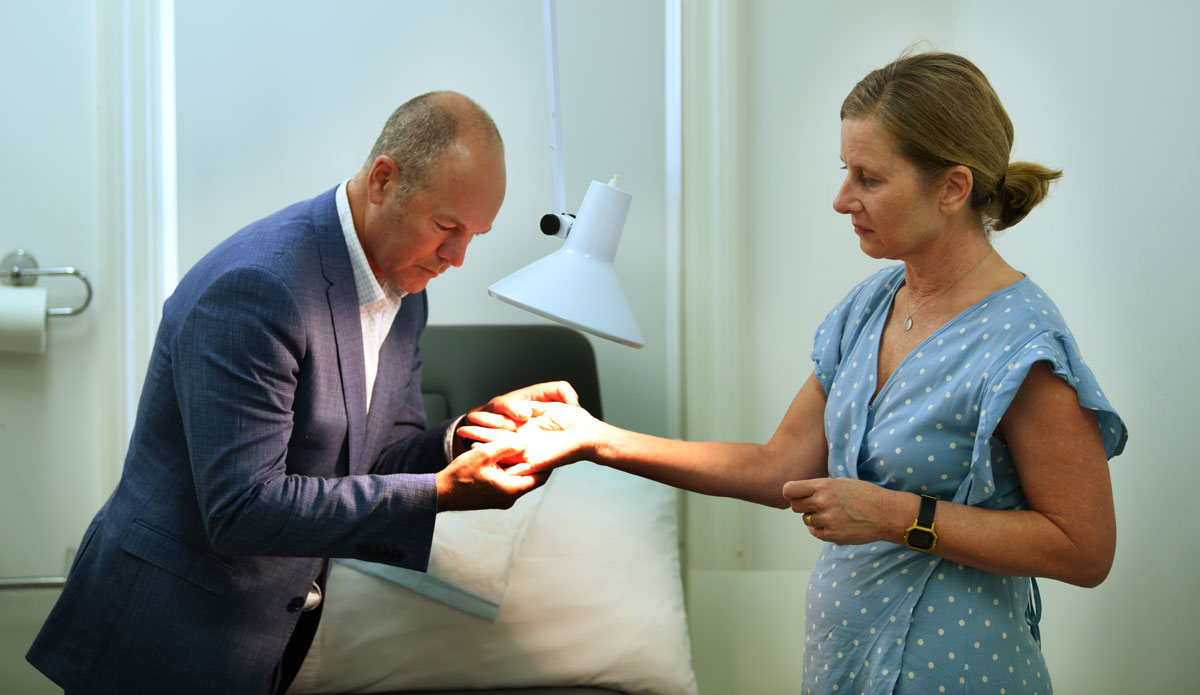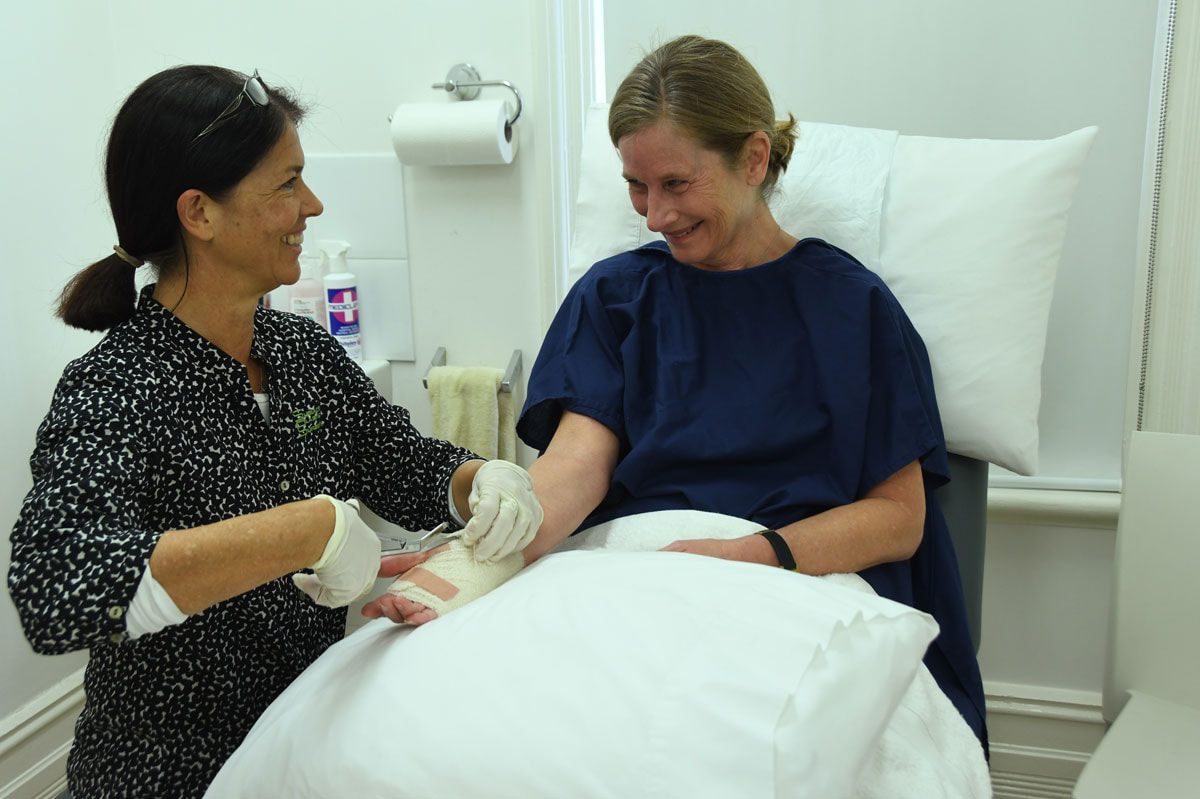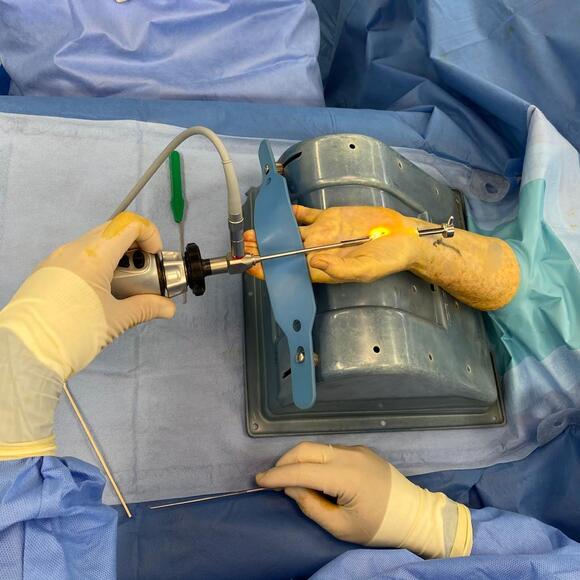Above image not a patient.
What is Carpal Tunnel Surgery?
Carpal tunnel surgery is the surgical lengthening or release of the flexor retinaculum in the palm of the hand. The release of this ligament takes the pressure off the Median nerve and this gives significant relief of symptoms to patients who have carpal tunnel syndrome. This surgical procedure is also called carpal tunnel release.
The surgery can be done as an endoscopic procedure (keyhole surgery) or with a longer incision in the palm.
Commonly used terms – numb hands, pins and needles in hand.
The surgery can be done as an endoscopic procedure (keyhole surgery) or with a longer incision in the palm.
Commonly used terms – numb hands, pins and needles in hand.
Endoscopic Carpal Tunnel Surgery
|
Dr Blennerhassett has been doing this operation as an endoscopic procedure for 20 years.
Usually there are two small incisions on the palm and wrist. Each is about 1cm in length. Through these small incisions, a camera is inserted into the carpal tunnel and the ligament can be released while the image is seen on a monitor. At the end of the surgery, the hand is wrapped in a supportive bandage and you are able to go home the same day. You will be provided with a sling, which helps you hold your hand elevated for the first couple of days. |
Carpal Tunnel Surgeon, Dr Lewis Blennerhassett
Dr Lewis Blennerhassett is a leading Perth carpal tunnel surgeon and has more than 25 years experience in this surgery.
He has trained extensively in hand surgery, including working closely with complex hand surgery expert Dr Joseph Upton, who is a clinical professor of surgery at Harvard Medical School and author of 250 articles and 60 book chapters on hand surgery.
Dr Blennerhassett’s reconstructive skills from his additional plastic surgery training ensure that his hand surgery is focused on being meticulous and precise. Expert care is provided, prioritising safety and quality.
In recent years, he has surgically created functional new thumbs for more than 100 WA children born without thumbs.
Carpal tunnel surgeon Dr Lewis Blennerhassett personally oversees your care from your first consultation through to full recovery. He is always happy to answer questions.
He has trained extensively in hand surgery, including working closely with complex hand surgery expert Dr Joseph Upton, who is a clinical professor of surgery at Harvard Medical School and author of 250 articles and 60 book chapters on hand surgery.
Dr Blennerhassett’s reconstructive skills from his additional plastic surgery training ensure that his hand surgery is focused on being meticulous and precise. Expert care is provided, prioritising safety and quality.
In recent years, he has surgically created functional new thumbs for more than 100 WA children born without thumbs.
Carpal tunnel surgeon Dr Lewis Blennerhassett personally oversees your care from your first consultation through to full recovery. He is always happy to answer questions.
What is Carpal Tunnel Syndrome?
|
Carpal tunnel syndrome is a series of symptoms and signs caused by the compression of a major nerve in the wrist and palm. This nerve is the Median nerve and it passes through the carpal tunnel, a narrow passageway in the wrist, which opens into the hand.
Classic symptoms for this condition include numbness, pins and needles, aching and an electric shock type feeling in the thumb, index, middle and ring fingers of the hand. The little finger is not usually involved in these symptoms. |
Symptoms can occur spontaneously at rest, or they can be brought on by certain activities such as holding a book or the steering wheel of a car. In many cases, symptoms are worse at night and wake the patient, causing them to shake their hand to try to relieve the symptoms.
Other symptoms and signs that are looked for are weakness or wasting of the muscles at the base of the thumb. However, it is best to have treatment before these signs are evident.
Other symptoms and signs that are looked for are weakness or wasting of the muscles at the base of the thumb. However, it is best to have treatment before these signs are evident.
What causes Carpal Tunnel Syndrome?
Most cases of carpal tunnel syndrome have no known cause.
In some cases, carpal tunnel syndrome will settle without treatment, especially if the underlying cause is treated (e.g. arthritis) or is no longer a contributing factor (e.g. pregnancy).
But generally, if carpal tunnel syndrome occurs for no obvious reason, it will in most cases persist and possibly slowly get more noticeable.
- Some are due to specific situations that lead to swelling in the wrists, such as injury or arthritis.
- Some are due to conditions that lead to fluid retention and generalised swelling – such as pregnancy.
- Mild symptoms can be made worse by overuse or repetitive use of the hand – e.g gardening.
In some cases, carpal tunnel syndrome will settle without treatment, especially if the underlying cause is treated (e.g. arthritis) or is no longer a contributing factor (e.g. pregnancy).
But generally, if carpal tunnel syndrome occurs for no obvious reason, it will in most cases persist and possibly slowly get more noticeable.
Who is at risk of Carpal Tunnel Syndrome?
Those most at risk of carpal tunnel syndrome are those who;
- have a job that involves repetitive movements of the wrist and hand
- have a family history
- have been pregnant or gone through menopause and retained fluid.
- are female, possibly due to women having a narrower carpel tunnel.
- have arthritis, diabetes or thyroid or pituitary gland issues.
- are overweight
- have a cyst or tumour in the area.
Are there any non-surgical treatments for Carpal Tunnel Syndrome?
Treatment of carpal tunnel syndrome varies according to its severity. In early and mild cases, treatment can sometimes be satisfactorily achieved by non-surgical measures;
For symptoms that are not responsive to these measures or if the symptoms are becoming more frequent, then often surgical intervention is required.
- Wearing splints for the wrists at night
- Changing certain postures for certain activities, such as using the computer keyboard etc.
- In some cases, an injection of an anti-inflammatory medicine into the carpal tunnel is recommended. This can give temporary relief of symptoms and can be useful in cases where surgery is not available or is not possible due to a medical condition.
For symptoms that are not responsive to these measures or if the symptoms are becoming more frequent, then often surgical intervention is required.
Does Carpal Tunnel Surgery require anaesthesia?
If surgical intervention is required, carpal tunnel surgeon Dr Lewis Blennerhassett normally performs endoscopic carpal tunnel surgery under a short general anaesthetic (patient asleep). However, it is possible to be discharged from hospital the same day as the surgery.
His hand surgery is performed only in fully accredited, fully equipped hospitals. His anaesthetists are skilled and highly qualified.
His hand surgery is performed only in fully accredited, fully equipped hospitals. His anaesthetists are skilled and highly qualified.
What do I need to do before Carpal Tunnel Surgery?
Management of carpal tunnel syndrome initially consists of making the correct diagnosis by excluding other potential causes for numbness and/or pain in the hand. A thorough assessment and examination by carpal tunnel surgeon Dr Lewis Blennerhassett is necessary for this.
In some cases, further testing is required, such as diagnostic studies that measure the electrical activity within the nerves of the hand. These can be arranged by Dr Blennerhassett if it is felt appropriate.
This may include:
In some cases, further testing is required, such as diagnostic studies that measure the electrical activity within the nerves of the hand. These can be arranged by Dr Blennerhassett if it is felt appropriate.
This may include:
- Electrodiagnostic Studies – Nerve Conduction and Electromyography - this involves measuring the conduction of electrical impulses in the Median nerve. It is a good test to perform if the diagnosis is not clear, or to assess the severity of the condition.
- Ultrasound or Magnetic Resonance Imaging (MRI) – in most cases these are not required. The majority of cases are diagnosed by a thorough history and examination plus electrodiagnostic studies. Ultrasound, MRI and X-rays are used in rare cases where there are other potential conditions also occurring in the wrist at the same time.
What do I need to do after Carpal Tunnel Surgery?
|
Time off work for carpal tunnel surgery depends upon the nature of the patient’s occupation. For office or desk-type activities, quite often a patient will be back at work within one week. For heavy manual work (such as brick-laying or other activities that involve using power tools etc) 4-6 weeks is often necessary as a period of recovery after the surgery before attempting a return to work.
Dressings changes, carried out by our expert nurses, will take place at Dr Blennerhassett’s Subiaco Plastic Surgery rooms until all healing is complete. |
During the recovery period, Dr Blennerhassett will be contactable to answer your questions. His mobile number will be provided to you during pre-surgery consultations.
Dr Blennerhassett’s patients are given a website password to access our highly specialised aftercare advice on recovery and scar management. Patient information sheets can also be provided.
Dr Blennerhassett’s patients are given a website password to access our highly specialised aftercare advice on recovery and scar management. Patient information sheets can also be provided.
Carpal Tunnel words to know
- Carpal Tunnel Release – another term for carpal tunnel surgery.
- Endoscopic procedure - allows the surgeon to observe the inside of the body without performing major surgery.
- Endoscope - a long flexible tube with a lens at one end and a video camera at the other.
*Follow Dr Lewis Blennerhassett on Instagram - @perthhandsurgeon




